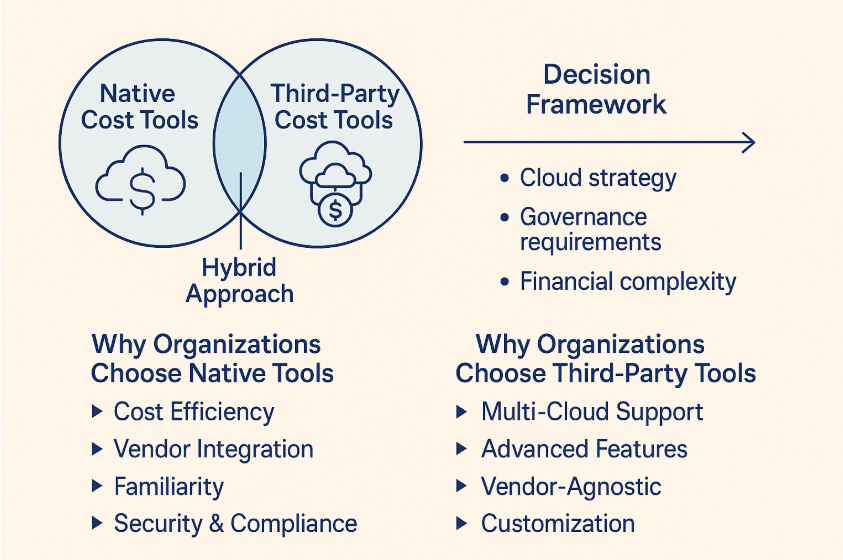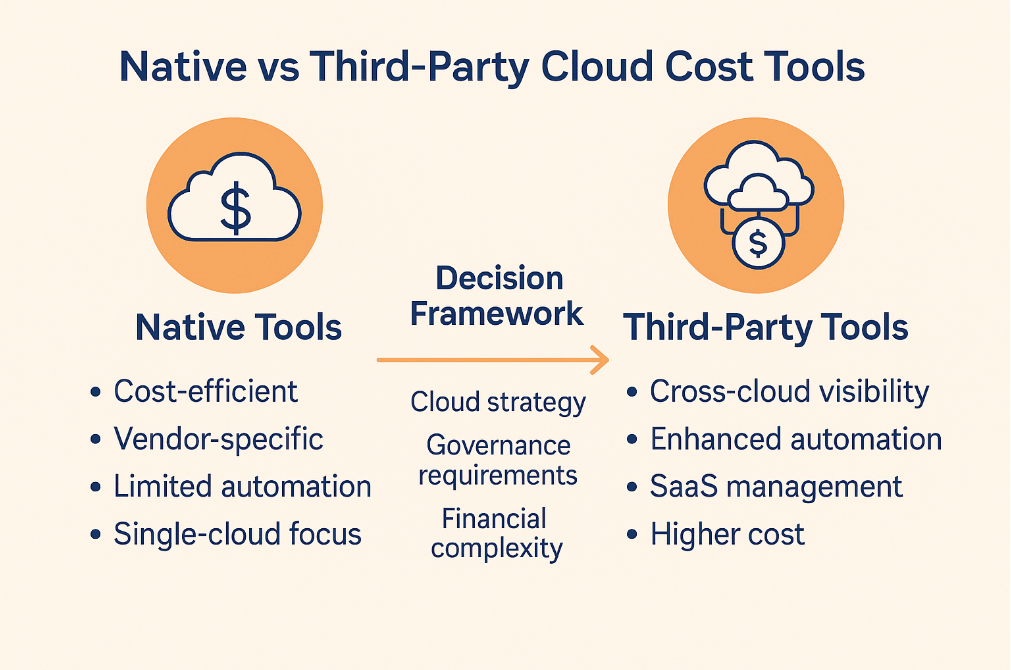
Cloud computing has become the backbone of modern business operations. From hosting applications to scaling infrastructure on demand, organizations now rely on providers like Amazon Web Services (AWS), Microsoft Azure, and Google Cloud Platform (GCP) to fuel growth and innovation. However, with this adoption comes a new challenge: managing and optimizing cloud costs effectively.
Gartner estimates that enterprises waste nearly 30% of their cloud budgets annually due to underutilized resources and lack of cost visibility. To address this, organizations often face a critical decision: should they rely on native cloud cost management tools provided by vendors, or adopt third-party cloud cost optimization platforms?
This article offers an in-depth analysis of native vs third-party cloud cost tools, their strengths, limitations, and the best-fit scenarios for enterprises in 2025. By the end, you’ll have a clear framework for deciding which approach aligns with your organization’s financial, operational, and strategic goals.
Understanding Cloud Cost Management
Before comparing native and third-party tools, it’s important to understand what cloud cost management entails. At its core, cloud cost management involves:
- Visibility – Knowing what resources are being consumed, by whom, and at what cost.
- Optimization – Identifying opportunities to rightsize, reserve, or eliminate resources.
- Forecasting – Using historical and real-time data to predict future spending.
- Governance – Establishing policies to prevent overspending and enforce accountability.
Both native tools and third-party platforms aim to achieve these goals, but they take very different approaches.

What Are Native Cloud Cost Tools?
Native cloud cost tools are solutions provided directly by cloud vendors to help customers manage spending within their ecosystems. These include AWS Cost Explorer, AWS Budgets, Azure Cost Management + Billing, and Google Cloud Billing Reports. They are tightly integrated into the vendor’s billing and monitoring systems, giving users an accurate and immediate view of resource consumption and related costs.
One of the biggest advantages of native tools is their real-time access to raw billing data. Since they are developed by the same company that runs the infrastructure, users can be confident that reporting is always consistent with invoices. In addition, vendors continuously update these tools with new cost-saving recommendations—for example, AWS offers rightsizing insights and reserved instance purchase recommendations based on historical usage.
Native tools also support tag-based cost allocation, allowing businesses to attribute spending to departments, projects, or teams. This is essential for basic chargeback and showback models within a single cloud. For organizations that prioritize tight integration with vendor services and don’t require cross-cloud visibility, native tools are a natural starting point for cost management.
What Are Third-Party Cloud Cost Tools?
Third-party platforms are vendor-agnostic tools designed to manage and optimize costs across multiple cloud providers. Leading platforms include Binadox, CloudHealth, Apptio Cloudability, and Spot by NetApp.
Unlike native tools, these solutions provide cross-cloud visibility—an essential feature for enterprises running hybrid or multi-cloud strategies. They also typically include:
- Advanced rightsizing recommendations
- Automated anomaly detection and alerting
- AI/ML-driven forecasting models
- SaaS spend management alongside cloud costs
- Integration with financial systems for chargeback/showback
For example, Binadox consolidates both cloud provider costs and SaaS application spending into a single dashboard. Its automation rules, license manager, and anomaly detection features allow IT and finance teams to act proactively rather than reactively.
Advantages of third-party tools:
- Centralized multi-cloud visibility
- Enhanced automation and anomaly detection
- SaaS spend management (not just cloud)
- Stronger governance and compliance features
Limitations:
- Additional licensing costs
- Integration complexity
- Potential overlap with native tool functionalities
Why Organizations Choose Native Tools
Organizations often opt for native cost management tools because of their simplicity, accessibility, and zero additional licensing costs. They are already included in most cloud subscriptions, making them budget-friendly, especially for smaller businesses or startups with limited IT resources. For companies with relatively straightforward environments—such as running a small number of workloads on a single provider—native tools offer enough visibility without overwhelming complexity.
Another reason organizations prefer native tools is their familiarity for DevOps and engineering teams. Since they are embedded directly into the same dashboards used for provisioning and monitoring workloads, engineers can check spending data without learning or logging into a separate platform. This ease of access often accelerates adoption within technical teams.
Native tools are also useful for organizations that want to leverage vendor-specific discounts or long-term commitments. For example, AWS Budgets helps businesses monitor whether they are making the most out of Reserved Instances or Savings Plans, while Azure provides optimization suggestions tailored to its hybrid cloud offerings.
In essence, organizations choose native tools when their cloud strategy is vendor-centric, cost-conscious, and operationally straightforward, where advanced governance or multi-cloud visibility is not a pressing need.
Why Organizations Choose Third-Party Tools
Enterprises with multi-cloud architectures, global operations, or complex compliance requirements Organizations with more complex environments, larger budgets, or multi-cloud strategies often turn to third-party platforms for deeper insights and automation. Unlike native tools, which primarily serve a reporting function, third-party platforms are designed to drive actionable optimization at scale.
For example, a multinational enterprise running workloads across AWS, Azure, and GCP may struggle with consolidating cost data. Native tools cannot generate a unified report across providers, which leads to fragmented visibility and manual reconciliation. Third-party platforms solve this by offering a single-pane-of-glass view across clouds and SaaS applications, making them invaluable for FinOps teams and CFOs who need consolidated reporting.
Third-party tools also excel in automation and anomaly detection. Instead of simply flagging a cost spike, they can trigger workflows that automatically stop idle resources, resize instances, or notify the appropriate department. This proactive management significantly reduces waste compared to the reactive nature of native tools.
Another factor is SaaS spend management. Most organizations today don’t just use cloud infrastructure—they also rely heavily on SaaS applications like Zoom, Slack, Salesforce, and Office 365. Native tools do not track SaaS subscriptions, but third-party platforms like Binadox integrate both SaaS and cloud spend, enabling IT and finance leaders to manage the entire technology stack in one place.
Ultimately, organizations choose third-party tools because they deliver scalability, automation, governance, and cross-platform intelligence that native tools cannot provide. They are best suited for businesses that want to transform cloud cost management from a reactive exercise into a strategic FinOps practice.
Challenges With Native Tools
While native tools are convenient, they come with significant drawbacks for growing organizations:
- Vendor Lock-In – Optimizations focus on the vendor’s ecosystem, making multi-cloud adoption harder.
- Limited Granularity – Reporting often lacks the flexibility needed for chargeback models.
- Reactive Optimization – Most native tools highlight cost spikes after they occur, rather than predicting them.
Challenges With Third-Party Tools
Third-party platforms aren’t without challenges:
- Additional Cost – Organizations must weigh subscription fees against potential savings.
- Implementation Complexity – Integrating with multiple providers and SaaS apps requires planning.
- Overlap – Some features may duplicate what native tools already provide, leading to redundancy.

Hybrid Approach: Best of Both Worlds
Many organizations are discovering that the most effective strategy isn’t choosing native tools or third-party tools exclusively, but rather combining them into a hybrid approach. This means leveraging native cost tools for their deep integration with the vendor ecosystem, while simultaneously using third-party platforms for cross-cloud visibility, automation, and governance.
For example, an engineering team may rely on AWS Cost Explorer to quickly review reserved instance recommendations and track daily AWS spend. At the same time, the finance or FinOps team uses Binadox or another third-party platform to consolidate reports across AWS, Azure, and GCP, and to monitor SaaS subscriptions across the organization. This layered approach allows technical and financial stakeholders to work with the data most relevant to them without duplicating efforts.
The hybrid model also helps address different levels of maturity within the organization. Early-stage teams can continue to use free native dashboards for tactical insights, while finance leaders and compliance officers benefit from the deeper analytics, policy enforcement, and anomaly detection that third-party platforms provide. Over time, the combination ensures that no cost-saving opportunities are missed, whether they are vendor-specific discounts or enterprise-wide waste reduction initiatives.
Improving Cost Efficiency With Binadox
Binadox exemplifies how third-party platforms go beyond what native tools offer. Its features include:
- SaaS & Cloud Visibility: Track all subscriptions and cloud services in one dashboard.
- Renewals Calendar: Avoid surprise SaaS renewals with proactive alerts.
- License Manager: Detect underutilized or abandoned SaaS licenses.
- Cloud Utilization Dashboard: Spot overpayment and manage daily budgets.
- Rightsizing & Automation: Automatically recommend and apply optimization actions.
- IaC Cost Tracker: Align Terraform deployments with budget forecasts.
With these capabilities, enterprises typically achieve 20–30% savings on cloud and SaaS spending.
Decision Framework: Native vs Third-Party
Deciding between native and third-party tools—or adopting a hybrid strategy—requires careful consideration of your organization’s structure, maturity, and objectives. Here’s a simple framework to guide the decision:
- Cloud Footprint
- Single-cloud strategy: Native tools may be sufficient, especially if workloads are concentrated on AWS, Azure, or GCP.
- Multi-cloud or hybrid environments: Third-party tools are essential to unify cost visibility across providers.
- SaaS Portfolio
- Few SaaS applications: Native cloud tools can manage infrastructure costs alone.
- Large SaaS footprint: A third-party platform like Binadox adds significant value by consolidating SaaS and cloud spend.
- Governance & Compliance
- Low regulatory burden: Native tools provide enough reporting for basic governance.
- Strict compliance or audit requirements: Third-party platforms offer advanced features like role-based access control, chargeback models, and anomaly detection.
- Financial Complexity
- Simple budgeting needs: Native dashboards and budget alerts may be enough.
- Complex cost structures: Enterprises with global operations, multi-currency payments, or departmental chargebacks benefit from third-party solutions.
- Resource Capacity
- Small IT teams: Native tools require minimal setup and are easy to use.
- Dedicated FinOps teams: Third-party tools provide the robust reporting, automation, and customization needed for enterprise-scale optimization.
By applying this framework, organizations can determine whether to start with cost-effective native tools, upgrade to enterprise-ready third-party platforms, or combine both for maximum impact. The right choice ensures cloud cost management becomes not just a reporting exercise, but a strategic enabler of growth and financial resilience.
Future Outlook: Cost Management in 2025 and Beyond
As cloud adoption matures, cost management will increasingly rely on automation, AI/ML-driven forecasting, and tighter integration with FinOps practices.
- Native tools will continue to evolve with stronger AI features and real-time recommendations.
- Third-party platforms will expand into areas like SaaS security, procurement, and governance.
- Enterprises will favor hybrid strategies, leveraging the strengths of both ecosystems to achieve sustainable, data-driven cost optimization.
Conclusion
The debate between native vs third-party cloud cost tools is not about which is universally better—it’s about what works best for your organization’s context.
- If you’re a single-cloud business with straightforward needs, native tools may be sufficient.
- If you’re managing multi-cloud environments, global operations, or large SaaS portfolios, third-party platforms like Binadox provide the visibility, automation, and governance you need.
Ultimately, the best solution often lies in a hybrid approach—using native tools for tactical insights while relying on third-party platforms for strategic, enterprise-wide optimization. By carefully assessing your requirements, you can unlock the full potential of cloud computing while keeping costs firmly under control.

